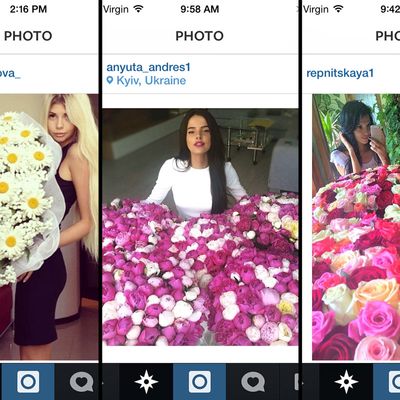
Why do we like what we like? Sometimes it’s woozily gratifying to pursue this question — to scan your bookshelf or iTunes and bask in the majesty of your tastes. Other times, it is shameful. Nothing good about my character, for example, can be inferred by the amount of time I spend leering at Russian women on Instagram. And not just general Russians, but a specific category of Russian. The sexy female kind who poses with a peculiar quantity of flowers. This is a curious trend of the past two years, and you’d best take a look for yourself because it’s more easily demonstrated than described.
My gateway drug was Elena Perminova, the Siberian-born wife of newspaper baron Alexander Lebedev and a woman with terrific taste in both swimwear and couture. It’s likely that Perminova is also the patient zero of the trend; she’s been on Instagram earlier and her billion-dollar lifestyle — villas in Umbria, private jets, Maldives vacations — is tear-jerkingly gorgeous (and aspirational only to the truly deluded). The rest of the Russians-with-flowers all follow Perminova, and mimic her signature Instagram displays: berry platters, pastel desserts, powder-room selfies. But mostly flowers.
Personally, a few things come to mind when faced with the flower pics. First, a recognition that at no point in my life will I receive a similar quantity of flowers. This is a something I can say with as much clarity as “I will never compete in the X Games” or “Nobody wants to hear me sing.” Until now, I didn’t know that anyone in the world received this quantity of flowers, or that anyone wanted to.
Next come the questions. Why do these women have so many flowers? Do they have a corresponding fleet of vases? And cabinet space for the vases? If each bouquet of roses contains a minimum of 12 aphids, and aphid females are capable of producing five offspring per day, how do they feel about breeding 66,000 aphids in their apartments by next week? Do their partners purchase the flowers ad hoc, or is it a standing-order situation? When they are eating, does the floral aroma compete with the food smells in a discordant way? What are all these flowers communicating?
Well, the last one is easy to answer. Receiving flowers means that you are loved. The tacit caption of each “flowergram” is “I am loved [x] amount,” where [x] is the number of flowers multiplied by the cost of flowers divided by the number of days elapsed since the last flower delivery. The species of flower should also factor into the equation somehow. Roses are the most covetable, followed by peonies, tulips, and Gerbera daisies, in that order. One woman tried to replicate the format with a selection of houseplants, but this left something to be desired.
As for the flower ladies, they have a few things in common. Their hair is long; their expressions are demure; their waists have the circumference of a sick child’s thigh. Sometimes their lipstick will match the flowers. Sometimes they will wear stripper heels, other times not. If not, their toes will be bare and pointed, to further elongate the leg, like a Barbie foot. Talk about performing femininity! Some of the women cleverly prop their flowers before a mirror to create the illusion of twice as many flowers. For the most part, they are not shown arranging or even selecting the flowers. Instead, they tilt plastic-wrapped bouquets lens-ward and submit to an iPhone snap. As hobbies go, this is one step above sleeping in its passivity. There are no photos of them doing any kind of work.
The comments are generally kind: “You deserve all this” or “Wow!!!!” or “Sweetheart, you are worthy of the most beautiful flowers.” Most are in Russian, though many are nothing but the rose emoji interspersed with clapping hands. Occasionally, a visitor will playfully suggest that the photographed woman has robbed a florist.
Some comments aim for poetry: “You are the epitome of spring, love, and beauty of a real woman!” Others connect the dots more explicitly: “What nose, oh! And ass! Incredible ass! Stunning flowers!”
If the medium is new, the tableaux are not. Flowers have always stoked the sexual imagination. Carl Linnaeus gave his young wife, Sara, the nickname of “monandrian lily” — a lily with one stamen (read: sexual partner) to satisfy its needs. (Gross.) A minor trendlet of fin-de-siècle painting involved nude females emerging from flowers, and Wagner’s Parsifal contains some salty lyrics about flowers widening their bowers so that the hero can play with them. There are also about a thousand French slang terms for clitoris that reference plant life. But you do not need to speak French or translate librettos to sense the sexual implications of comely women surrounded by moist pink petals. Anyone who has shuddered at the term “breast bud” will understand.
A more direct historical antecedent might be John Singer Sargent’s 1899 portrait of the Wyndham sisters, which features a trio of languid beauties wreathed on three sides by magnolias. The women’s dresses are expensive, their collarbones prominent, their faces blanker than a fistful of marshmallows. Straighten the hair, shrink the dresses, spray-tan the flesh, and you’ve got yourself an Instagram photo. Double-tap to like.

